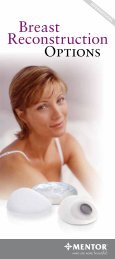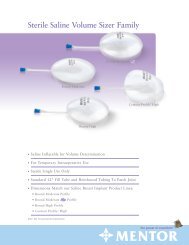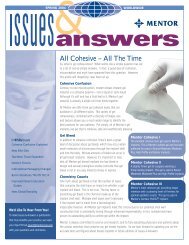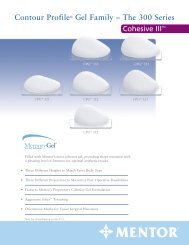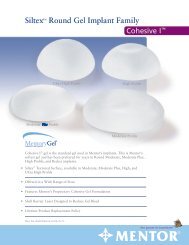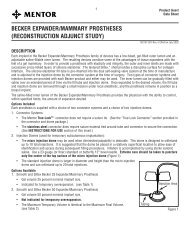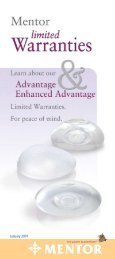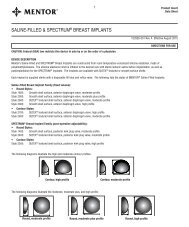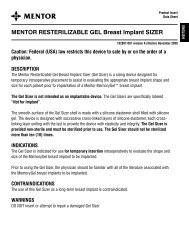Saline-Filled and Spectrum⢠Breast Implants - Mentor
Saline-Filled and Spectrum⢠Breast Implants - Mentor
Saline-Filled and Spectrum⢠Breast Implants - Mentor
Create successful ePaper yourself
Turn your PDF publications into a flip-book with our unique Google optimized e-Paper software.
<strong>Mentor</strong> Corporation<br />
P990075/S21/A03<br />
<strong>Saline</strong> <strong>Filled</strong> <strong>Breast</strong> <strong>Implants</strong><br />
INDICATIONS<br />
<strong>Breast</strong> implants are indicated for females for the following indications:<br />
• <strong>Breast</strong> Augmentation. A woman must be at least 18 years old for breast augmentation.<br />
• <strong>Breast</strong> Reconstruction.<br />
CONTRAINDICATIONS<br />
Patient Groups in which the product is contraindicated:<br />
• Active infection anywhere in the body.<br />
• Existing malignant or pre-malignant breast cancer without adequate treatment.<br />
• Augmentation in women who are currently pregnant or nursing.<br />
Surgical Practices in which product use is contraindicated due to compromise of product integrity:<br />
• Stacking of implants: Do not place more than one implant per breast pocket.<br />
• Do not make injections into the implant.<br />
• Do not alter the implant shell or valve.<br />
• Do not place drugs or substances inside the implant other than sterile saline for injection.<br />
• Do not allow the implant to come in contact with Betadine®.*<br />
WARNINGS<br />
1. Closed Capsulotomy<br />
DO NOT treat capsular contracture by forceful external compression, which will likely result in implant damage, deflation, folds, <strong>and</strong>/or hematoma.<br />
Capsule firmness must not be treated by overexpansion of the device.<br />
2. Reuse<br />
<strong>Breast</strong> implants are intended for single use only. Do not resterilize.<br />
3. Avoiding Damage during Surgery<br />
• Care should be taken not to damage the prosthesis with surgical instruments.<br />
• Do not insert or attempt to repair a damaged prosthesis.<br />
• Use care in subsequent procedures such as open capsulotomy, breast pocket revision, hematoma/seroma aspiration, <strong>and</strong> biopsy/lumpectomy to avoid<br />
damage to the implant shell or valve.<br />
• Do not contact the implant with disposable, capacitor-type cautery devices.<br />
4. Proper Filling<br />
Follow the recommendation on the product data sheet for fill volume; do not overfill or underfill the implant.<br />
Underfilled prostheses may buckle, fold or wrinkle, causing crease/fold failure of the device, <strong>and</strong> subsequent deflation can occur.<br />
Additionally, inflation beyond the maximum volume can also cause crease/fold failure <strong>and</strong> deflation.<br />
5. Microwave Diathermy<br />
The use of microwave diathermy in patients with breast implants is not recommended, as it has been reported to cause tissue necrosis, skin erosion, <strong>and</strong><br />
extrusion of the implant.<br />
6. Do not use endoscopic placement or periumbilical approach in placement of the implant.<br />
PRECAUTIONS<br />
1. Specific Populations<br />
Safety & Effectiveness has not been established in patients with:<br />
• Autoimmune diseases such as lupus <strong>and</strong> scleroderma.<br />
• A compromised immune system (e.g., currently receiving immunosuppressive therapy).<br />
• Patients with conditions or medications which interfere with wound healing ability (such as poorly controlled diabetes) or blood clotting (such as<br />
concurrent coumadin therapy).<br />
• Reduced blood supply to breast tissue.<br />
*Betadine® is a registered trademark of the Purdue Frederic Company.<br />
2<br />
Attachment 2



